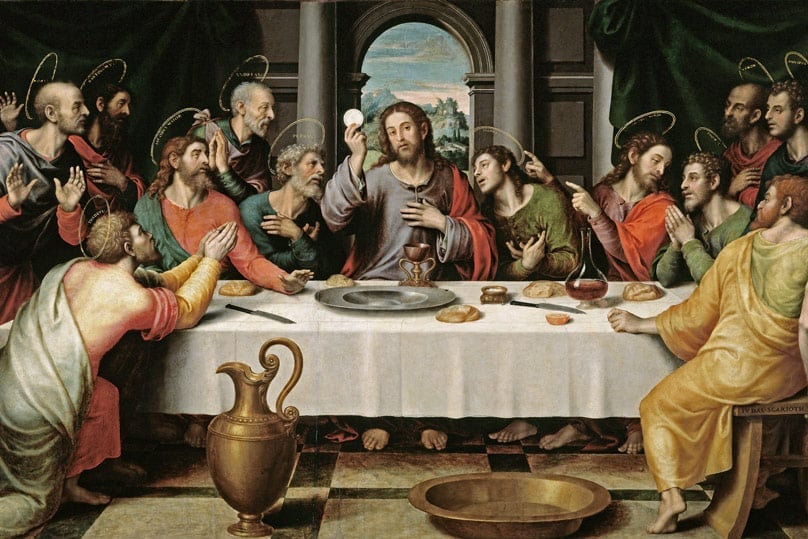
Dear Fr John Flader, someone told me there are a lot of parallels between the Jewish Passover meal, the Seder, and the Eucharist. Is this true?
Yes, it is. Not for nothing did Our Lord choose the very celebration of the Passover meal in which to celebrate the Last Supper with his apostles and to institute the Eucharist.
It must always be remembered that when we speak of the Last Supper, we are inclined to think that it was simply the last meal Jesus ate with the apostles before his passion and death. But this was no ordinary meal.
The Seder was a sacred ritual, involving retelling the liberation of the Israelites from slavery in Egypt, and its different parts were prescribed in detail. It fulfilled what God had commanded: “You shall tell your son on that day, ‘It is because of what the Lord did for me when I came out of Egypt’” (Ex 13:8).
The Seder is full of symbolism, some of which is the following.
During the Seder, the head of the family takes three pieces of unleavened bread, called matzah, reminding us of the Father, the Son, and the Holy Spirit.
He breaks in half the second piece, suggesting the Second Person of the Blessed Trinity, Jesus, crucified. He wraps one of these two pieces, called the afikomen, in white linen, reminding us of Jesus’ burial in a linen cloth.
He then “buries” or hides it, as Jesus was buried in the tomb. Later the youngest child “resurrects” or finds the afikomen, a symbol of Jesus rising from the dead.
The family head then breaks the afikomen and blesses it, as Christ did in the Last Supper, saying: “Blessed are You, Lord, our God, King of the universe, who brings forth bread from the earth.”
He then passes it around for all to eat, as Jesus did in giving his body to the apostles as communion, and as we do in Holy Communion.
The matzah is eaten with bitter herbs, a reminder of the bitterness of slavery in Egypt. The unleavened bread also reminds us of the haste with which the Israelites left Egypt. It represents our need to remain ever alert and prepared for the day when God calls us, as Jesus taught: “Watch, therefore, for you know neither the day nor the hour” (Mt 25:13).
When the afikomen is broken and passed around for all to eat, Jews drink the third of four cups of wine, called the cup of blessing because it represents the blood of the sacrificed paschal lamb.
It was this third cup that Jesus gave to his apostles in the Last Supper when he said, “This cup which is poured out for you is the New Covenant in my Blood” (Lk 22:20).
It was not the blood of an animal, such as that which Moses had sprinkled over the people, saying: “Behold the blood of the covenant which the Lord has made with you in accordance with all these words” (Ex 24:8).
In the Easter Vigil, the antiphon of one of the psalms refers to this cup of blessing: “Our blessing cup is a communion in the blood of Christ.”
Jesus did not drink the fourth, or Kalah, cup in the Last Supper. He explained: “I tell you I shall not drink again of this fruit of the vine until that day when I drink it new with you in my Father’s kingdom” (Mt 26:29).
Later that evening in the garden of Gethsemane, Jesus prayed to be spared that cup of suffering: “Father, if it be possible, let this cup pass from me” (Mt 26:39). After he was arrested, Jesus asked Peter: “Shall I not drink the cup the Father has given me?” (Jn 18:11).
Many believe that Jesus drank that last cup, the cup of suffering, by undergoing his passion and death on the Cross: “They put a sponge full of the vinegar on hyssop and held it to his mouth. When Jesus had received the vinegar, he said, ‘It is finished’; and he bowed his head and gave up his spirit” (Jn 19:30).
The new and definitive Passover, now celebrated in the Mass, ended with the drinking of the fourth cup of suffering, thus coming to an end when Jesus finally breathed his last.
At the time of Christ, when the Jewish high priest had killed the last lamb of the Passover in the Temple, he said in Hebrew: Kalah, “It is finished”, the same words Christ said on the Cross before he died (cf. Jn 19:30).
The Passover Seder concluded with the singing of the Hallel Psalms (Ps. 112-117 and the “Great Hallel,” Psalm 135), which are hymns of praise.
